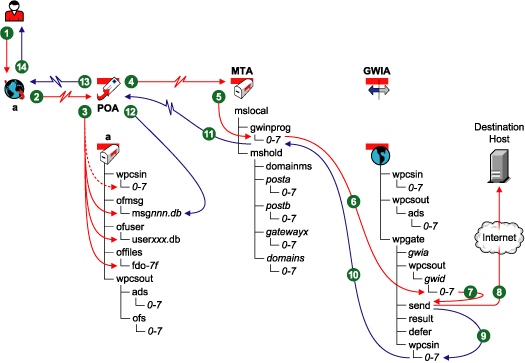4.3 Mapped/UNC Link Open: Outbound Transfer to the Internet Successful
This message flow diagram shows how outbound messages travel through the GroupWise directory structure to the Internet when there is a mapped/UNC link between the MTA and the GWIA and when the GWIA can communicate successfully with the Internet host to which the message is addressed.

|
Stage |
Icon |
Description |
|---|---|---|
|
|
|
The user sends a message to recipients across the Internet by providing their Internet addresses. In this diagram, the access mode setting for the local post office is Client/Server Only. |
|
|
|
The GroupWise client communicates the message to the POA by way of TCP/IP. |
|
|
|
The POA receives the message from the GroupWise client and performs the following actions for the sender:
|
|
|
|
The POA then communicates the message to the MTA for the sender’s domain by way of TCP/IP, and deletes the copy in the MTA input queue because the TCP/IP transfer to the MTA was successful. |
|
|
|
The MTA for the sender’s domain receives the message and places it into the MTA “in progress” (gwinprog) queue. |
|
|
|
The MTA determines that the message must be sent out across the Internet. Because there is a mapped/UNC link between the MTA and the GWIA, the MTA places the message in its output queue in the GWIA’s gateway directory (domain/wpgate/gwia/wpcsout/gwid/0-7). |
|
|
|
The GWIA scans its input queues according to the setting on the Gateway Time Settings page of the GWIA object in ConsoleOne. The GWIA picks up the file in binary-encrypted format from the wpcsout/gwid/0-7 directory and converts it. The GWIA encodes the message in MIME format with the appropriate encoding scheme. When the message file is built, the GWIA saves it with S as the first character of the file name and places the message file in the domain/wpgate/gwia/send directory for processing. |
|
|
|
While the GWIA is processing the message file in the send directory, it changes the first character of the file name to P. When processing is completed, the GWIA sends the message to the destination host across the Internet. |
|
|
|
If the GWIA receives a 250 OK SMTP reply code from the destination Internet host, it places a Transferred status message into the input queue of the MTA for the sender’s domain. |
|
|
|
Because of its mapped/UNC link with the GWIA, the MTA regularly scans its input queue in the GWIA’s gateway directory based on the setting on the Agent Settings page of the MTA object in ConsoleOne. It picks up the Transferred status messages and transfers them to its “in progress“ (gwinprog) directory for processing. |
|
|
|
The MTA for the sender’s domain communicates the Transferred status messages to the POA for the sender’s post office by way of TCP/IP. |
|
|
|
The POA for the sender’s post office updates the sender’s message database (msgnnn.db) with the Transferred status information. |
|
|
|
The POA for the sender’s post office communicates the Transferred status to the sender’s GroupWise client by way of TCP/IP. |
|
|
|
When the sender checks the sent items in his or her mailbox in the GroupWise client, the message displays the Transferred status because the GWIA was able to sent it successfully. |
 Sender
Sender

 Sender’s GroupWise Client
Sender’s GroupWise Client

 POA for Sender’s Post Office
POA for Sender’s Post Office

 POA for Sender’s Post Office
POA for Sender’s Post Office
 MTA for Sender’s Domain
MTA for Sender’s Domain

 MTA for Sender’s Domain
MTA for Sender’s Domain
 GWIA for Sender’s Domain
GWIA for Sender’s Domain

 GWIA for Sender’s Domain
GWIA for Sender’s Domain
 GWIA for Sender’s Domain
GWIA for Sender’s Domain
 MTA for Sender’s Domain
MTA for Sender’s Domain
 MTA for Sender’s Domain
MTA for Sender’s Domain
 POA for Sender’s Post Office
POA for Sender’s Post Office
 POA for Sender’s Post Office
POA for Sender’s Post Office
 Sender
Sender